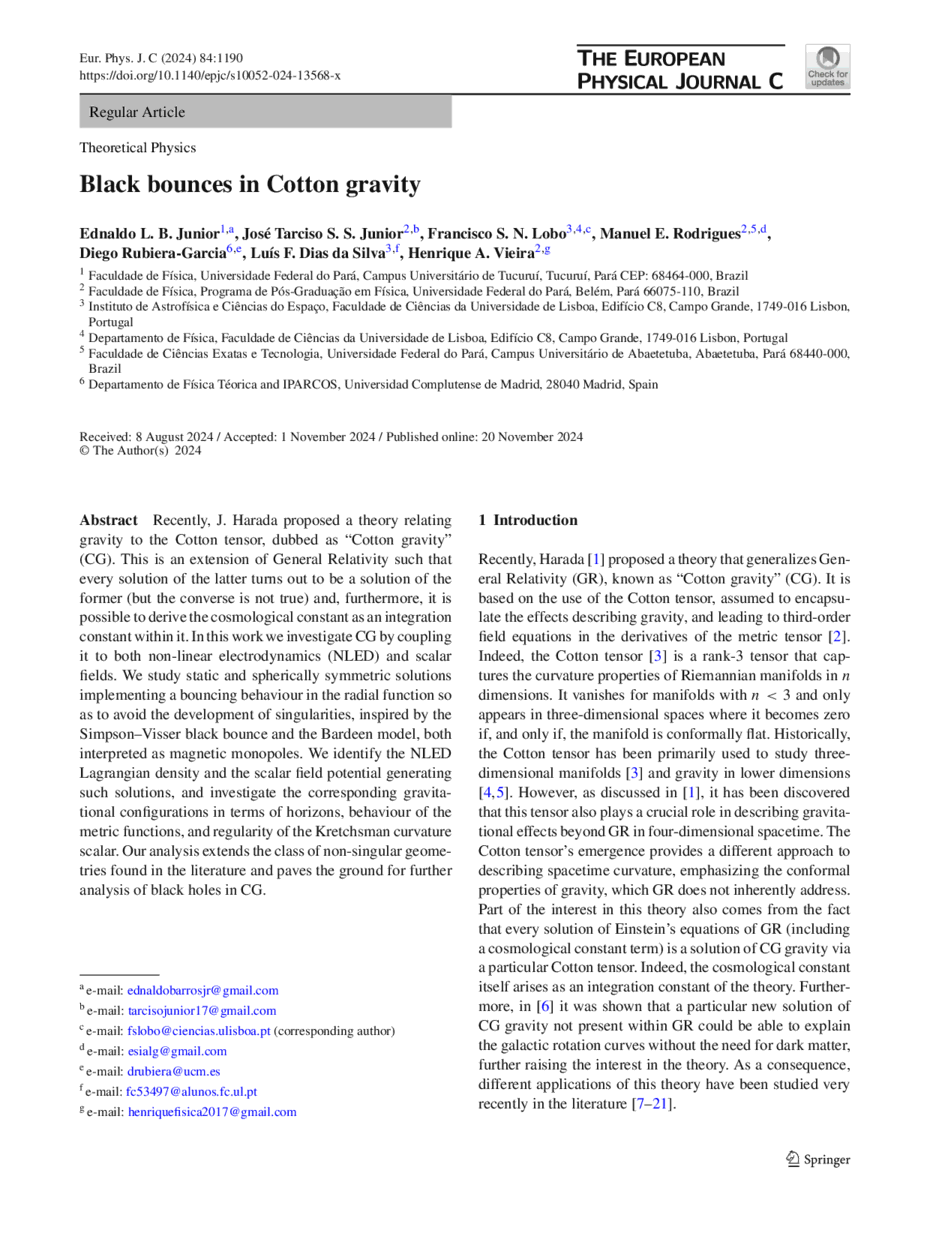https://doi.org/10.1140/epjc/s10052-024-13568-x
Regular Article
Black bounces in Cotton gravity
1
Faculdade de Física, Universidade Federal do Pará, Campus Universitário de Tucuruí, CEP: 68464-000, Tucuruí, Pará, Brazil
2
Faculdade de Física, Programa de Pós-Graduação em Física, Universidade Federal do Pará, 66075-110, Belém, Pará, Brazil
3
Instituto de Astrofísica e Ciências do Espaço, Faculdade de Ciências da Universidade de Lisboa, Edifício C8, Campo Grande, 1749-016, Lisbon, Portugal
4
Departamento de Física, Faculdade de Ciências da Universidade de Lisboa, Edifício C8, Campo Grande, 1749-016, Lisbon, Portugal
5
Faculdade de Ciências Exatas e Tecnologia, Universidade Federal do Pará, Campus Universitário de Abaetetuba, 68440-000, Abaetetuba, Pará, Brazil
6
Departamento de Física Téorica and IPARCOS, Universidad Complutense de Madrid, 28040, Madrid, Spain
Received:
8
August
2024
Accepted:
1
November
2024
Published online:
20
November
2024
Recently, J. Harada proposed a theory relating gravity to the Cotton tensor, dubbed as “Cotton gravity” (CG). This is an extension of General Relativity such that every solution of the latter turns out to be a solution of the former (but the converse is not true) and, furthermore, it is possible to derive the cosmological constant as an integration constant within it. In this work we investigate CG by coupling it to both non-linear electrodynamics (NLED) and scalar fields. We study static and spherically symmetric solutions implementing a bouncing behaviour in the radial function so as to avoid the development of singularities, inspired by the Simpson–Visser black bounce and the Bardeen model, both interpreted as magnetic monopoles. We identify the NLED Lagrangian density and the scalar field potential generating such solutions, and investigate the corresponding gravitational configurations in terms of horizons, behaviour of the metric functions, and regularity of the Kretchsman curvature scalar. Our analysis extends the class of non-singular geometries found in the literature and paves the ground for further analysis of black holes in CG.
© The Author(s) 2024
 Open Access This article is licensed under a Creative Commons Attribution 4.0 International License, which permits use, sharing, adaptation, distribution and reproduction in any medium or format, as long as you give appropriate credit to the original author(s) and the source, provide a link to the Creative Commons licence, and indicate if changes were made. The images or other third party material in this article are included in the article’s Creative Commons licence, unless indicated otherwise in a credit line to the material. If material is not included in the article’s Creative Commons licence and your intended use is not permitted by statutory regulation or exceeds the permitted use, you will need to obtain permission directly from the copyright holder. To view a copy of this licence, visit http://creativecommons.org/licenses/by/4.0/.
Open Access This article is licensed under a Creative Commons Attribution 4.0 International License, which permits use, sharing, adaptation, distribution and reproduction in any medium or format, as long as you give appropriate credit to the original author(s) and the source, provide a link to the Creative Commons licence, and indicate if changes were made. The images or other third party material in this article are included in the article’s Creative Commons licence, unless indicated otherwise in a credit line to the material. If material is not included in the article’s Creative Commons licence and your intended use is not permitted by statutory regulation or exceeds the permitted use, you will need to obtain permission directly from the copyright holder. To view a copy of this licence, visit http://creativecommons.org/licenses/by/4.0/.
Funded by SCOAP3.





